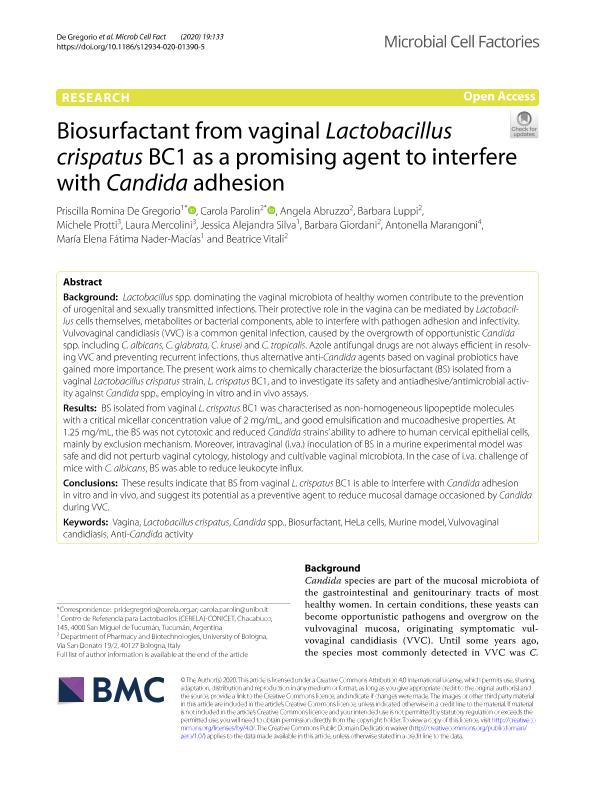Mostrar el registro sencillo del ítem
dc.contributor.author
de Gregorio, Priscilla Romina

dc.contributor.author
Parolin, Carola
dc.contributor.author
Abruzzo, Angela
dc.contributor.author
Luppi, Barbara
dc.contributor.author
Protti, Michele
dc.contributor.author
Mercolini, Laura
dc.contributor.author
Silva, Jessica Alejandra

dc.contributor.author
Giordani, Barbara
dc.contributor.author
Marangoni, Antonella
dc.contributor.author
Nader, Maria Elena Fatima

dc.contributor.author
Vitali, Beatrice
dc.date.available
2021-08-12T18:28:29Z
dc.date.issued
2020-06-18
dc.identifier.citation
de Gregorio, Priscilla Romina; Parolin, Carola; Abruzzo, Angela; Luppi, Barbara; Protti, Michele; et al.; Biosurfactant from vaginal Lactobacillus crispatus BC1 as a promising agent to interfere with Candida adhesion; BioMed Central; Microbial Cell Factories; 19; 133; 18-6-2020; 1-16
dc.identifier.issn
1475-2859
dc.identifier.uri
http://hdl.handle.net/11336/138222
dc.description.abstract
Lactobacillus spp. dominating the vaginal microbiota of healthy women contribute to the prevention of urogenital and sexually transmitted infections. Their protective role in the vagina can be mediated by Lactobacillus cells themselves, metabolites or bacterial components, able to interfere with pathogen adhesion and infectivity. Vulvovaginal candidiasis (VVC) is a common genital infection, caused by the overgrowth of opportunistic Candida spp. including C. albicans, C. glabrata, C. krusei and C. tropicalis. Azole antifungal drugs are not always efcient in resolv ing VVC and preventing recurrent infections, thus alternative anti-Candida agents based on vaginal probiotics have gained more importance. The present work aims to chemically characterize the biosurfactant (BS) isolated from a vaginal Lactobacillus crispatus strain, L. crispatus BC1, and to investigate its safety and antiadhesive/antimicrobial activ ity against Candida spp., employing in vitro and in vivo assays. Results: BS isolated from vaginal L. crispatus BC1 was characterised as non-homogeneous lipopeptide molecules with a critical micellar concentration value of 2 mg/mL, and good emulsifcation and mucoadhesive properties. At 1.25 mg/mL, the BS was not cytotoxic and reduced Candida strains? ability to adhere to human cervical epithelial cells, mainly by exclusion mechanism. Moreover, intravaginal (i.va.) inoculation of BS in a murine experimental model was safe and did not perturb vaginal cytology, histology and cultivable vaginal microbiota. In the case of i.va. challenge of mice with C. albicans, BS was able to reduce leukocyte infux. Conclusions: These results indicate that BS from vaginal L. crispatus BC1 is able to interfere with Candida adhesion in vitro and in vivo, and suggest its potential as a preventive agent to reduce mucosal damage occasioned by Candida during VVC.
dc.format
application/pdf
dc.language.iso
eng
dc.publisher
BioMed Central

dc.rights
info:eu-repo/semantics/openAccess
dc.rights.uri
https://creativecommons.org/licenses/by-nc-sa/2.5/ar/
dc.subject
VAGINA
dc.subject
LACTOBACILLUS CRISPATUS
dc.subject
CÁNDIDA SPP.
dc.subject
BIOSURFACTANT
dc.subject
MURINE MODEL
dc.subject
HELA CELLS
dc.subject
VULVOVAGINAL CANDIDIASIS
dc.subject
ANTY-CANDIDA ACTIVITY
dc.subject.classification
Biología Celular, Microbiología

dc.subject.classification
Ciencias Biológicas

dc.subject.classification
CIENCIAS NATURALES Y EXACTAS

dc.title
Biosurfactant from vaginal Lactobacillus crispatus BC1 as a promising agent to interfere with Candida adhesion
dc.type
info:eu-repo/semantics/article
dc.type
info:ar-repo/semantics/artículo
dc.type
info:eu-repo/semantics/publishedVersion
dc.date.updated
2021-07-01T13:51:05Z
dc.journal.volume
19
dc.journal.number
133
dc.journal.pagination
1-16
dc.journal.pais
Reino Unido

dc.journal.ciudad
Londres
dc.description.fil
Fil: de Gregorio, Priscilla Romina. Consejo Nacional de Investigaciones Científicas y Técnicas. Centro Científico Tecnológico Conicet - Tucumán. Centro de Referencia para Lactobacilos; Argentina
dc.description.fil
Fil: Parolin, Carola. Universidad de Bologna; Italia
dc.description.fil
Fil: Abruzzo, Angela. Universidad de Bologna; Italia
dc.description.fil
Fil: Luppi, Barbara. Universidad de Bologna; Italia
dc.description.fil
Fil: Protti, Michele. Universidad de Bologna; Italia
dc.description.fil
Fil: Mercolini, Laura. Universidad de Bologna; Italia
dc.description.fil
Fil: Silva, Jessica Alejandra. Consejo Nacional de Investigaciones Científicas y Técnicas. Centro Científico Tecnológico Conicet - Tucumán. Centro de Referencia para Lactobacilos; Argentina
dc.description.fil
Fil: Giordani, Barbara. Universidad de Bologna; Italia
dc.description.fil
Fil: Marangoni, Antonella. Universidad de Bologna; Italia
dc.description.fil
Fil: Nader, Maria Elena Fatima. Consejo Nacional de Investigaciones Científicas y Técnicas. Centro Científico Tecnológico Conicet - Tucumán. Centro de Referencia para Lactobacilos; Argentina
dc.description.fil
Fil: Vitali, Beatrice. Universidad de Bologna; Italia
dc.journal.title
Microbial Cell Factories

dc.relation.alternativeid
info:eu-repo/semantics/altIdentifier/doi/http://dx.doi.org/10.1186/s12934-020-01390-5
dc.relation.alternativeid
info:eu-repo/semantics/altIdentifier/url/https://microbialcellfactories.biomedcentral.com/articles/10.1186/s12934-020-01390-5
Archivos asociados
